Life In Montenegro
Just a few short months ago I would have been completely unable to tell you where Montenegro was on a map. But after having spent 43 days in this small Adriatic country south of Croatia and north of Albania on the Adriatic coast, I’ve a raving fan.
I cycled into Montenegro from Croatia on the 13th of May, 2009. After no more than an hour’s worth of riding, I found myself in the small coastal town of Herceg Novi, perched on a hillside near the entrance to the Gulf of Kotor.
After finding a small apartment to rent for the night, I spent the evening walking around town, strolling the local shops, eating pizza, and mixing with the locals. “This place is nice” I thought to myself. “Maybe I should stay here for a while?”
But I could do no such thing! I had already made a 40-night reservation for an apartment in the town of Tivat, a small coastal city of approximately 15,000 located across the Gulf, about 20 kilometers away.
I had arranged to meet the owner of my Tivat apartment at 5 PM at the ferry landing three miles north of the city. But it wasn’t even noon yet, so I spent the day cycling around the Bay of Kotor, one of Montenegro’s most famous landmarks and most notable geographic features.
In the middle of the Bay sat the islands I had, up to this point in my life, only seen in photographs. Our Lady of the Rocks, the floating church in the middle of the Bay built in Roman Catholic architecture, remained a prominent fixture throughout the day as I slowly made my way around to Kotor and back to the Lepetane ferry landing where I was to meet the apartment owner.
At 5 PM, there he was. Ratko was his name and he wore a bright orange polo shirt made up of red and yellow horizontal stripes. He seemed to be in a rush as we frantically loaded my bike into his car and took off toward town.
Ratko spoke little English, but more than I expected any resident of this tiny seaside country to speak or understand. As he showed me into my apartment I asked him, “How did you learn so much English? Did you learn it in school? Or simply from talking with tourists?”
“Yes!” he replied. But I was left wondering exactly which question he was responding to.
My apartment was nice. It was located in the center of a three story home, just off the main street that runs through town and directly across from the local city park where goats run wild and women sometime tan in the nude.
I had a small living room with a widescreen TV (which didn’t work), a computer (which I never used because I brought my own laptop) and two large red leather couches. In addition, there was a small kitchenette, a bathroom, and a luxurious bedroom with a gigantic dresser and a plush queen-size bed.
The only thing my temporary home lacked was a view. Two large windows were located on either side of the unit, but the only thing I could see out of them were the walls of the neighbors’ homes.

Here I am working via laptop from my apartment in Tivat, Montenegro.
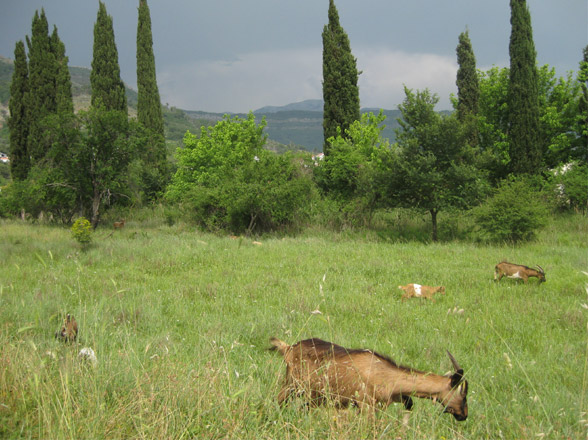
These are just some of the goats that roamed through the nearby city park.
After I was shown around, Ratko said goodbye, closed the door and I was left to myself. I was alone yet again… and for the next month at least, I would remain that way, speaking to only a handful of people for the remainder of my time in Montenegro.
Unfortunately, my second day in Tivat left me with a negative impression from the get-go.
A kitten had been hit by a car right outside my hillside apartment building. Blood was leaking from it’ head and as I approached the baby cat on foot, I thought it might still be alive. It wasn’t however, and the thought of someone running it over and then leaving it in the street to be run over again and again left me with a negative image of the people I might meet in this tiny coastal town.
Further sadness crept in when I discovered five puppies that had been abandoned by some irresponsible owner in a nearby park.
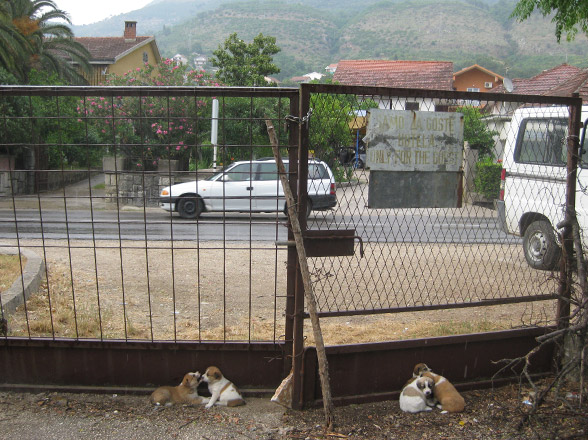
And time and time again, I saw dead animals along the roadside, kicked into the gutter or thrown into the bushes and simply forgotten about.
My happy go-lucky mood had shifted to a state of depression and regret. I was wishing I hadn’t come to this place. I was regretting having to stay for so long. And in many ways, I wanted to just come home.
But a few days passed and my dark mood lifted.
My first week in Tivat was spent doing what I always do when I find myself in a new place – I walked around aimlessly. Getting lost can be a good thing when traveling to a new locale, because it forces you to find places and experience things you might not have ever found or experienced otherwise. And it was these random walks around the city that changed my overall impression of Montenegro and the people that live there.
One of my favorite places to walk to in Tivat was the soccer field on the north side of town. It was about a 30-minute walk to get there from my apartment, but it was worth it because I loved watching the games take place. Men of all ages were on the field. Some were wearing athletic shorts and shirts, while others were dressed in jeans and polos – even in the 100+ degree weather.
I tried to get in on a few games myself, but with no such luck. I later learned that the players were paying to join these scrimmages and that I would be unable to play with the locals unless I joined a team and paid up like the rest of them. Had I been staying longer, I gladly would have.
Downtown Tivat was where the tourists, if there were any, hung out. Large palm trees lined the street and a long row of restaurants and outdoor eateries ran the entire length of the street. All day long, people sat underneath the restaurant awnings and peered out at the people walking past – something I quickly learned is a favorite undertaking in Montenegro.

The tourist area of Tivat.
The advantage of staying in one place for an extended period of time is that you get to see how things are in these places on a daily basis. You pick up the patterns of daily life and see the same people day after day.

The paint store and the main road that runs through Tivat, Montenegro.

One of the major intersections in downtown Tivat.

Women enjoying the warm water of the Gulf of Kotor on a cloudy day in Montenegro.
On my walk into town each day, the man at the paint store, who slept in his car at night to guard his paint and building supplies, would nod his head at me as I walked passed.
And the old balding fat man in the alley than ran from the corner bakery to the beach never seemed to move. No matter whether I walked past at 8 in the morning or 10 o’ clock at night, he was always there, sitting in his chair outside his tiny run-down apartment. He never had his shirt on. He was never reading a book or talking with other residents. He was just sitting there, watching people walk past, day… after day… after day.
Then there was the blond haired woman in the tourist agency, whom I had talked to on my first day in Tivat, and whom I seemed to keep running into no matter where I was in town.
Boys on bicycles quickly learned who I was and I too began to recognize the clanking sounds of their bicycle wheels long before I ever saw them coming.
And the bar maidens at the Exit Pizzeria on the south side of town quickly learned that a vegetarian pizza in a box was all I really wanted.
After just a couple weeks in Tivat, I felt like one of the locals and the place that had shocked me so much at first had now surprisingly grown on me.
During my time in Tivat, I would spend my weekdays doing work. I’d write articles for BicycleTouringPro.com, work on marketing for my clients in California, and plan my travels for the coming weeks and months ahead.
On the weekends I would take bus trips to nearby cities. I spent much of my time in Kotor, a large fortified city on the south side of The Bay of Kotor. And trips to Budva, Bar, Sutomore and other coastal towns were made as well.
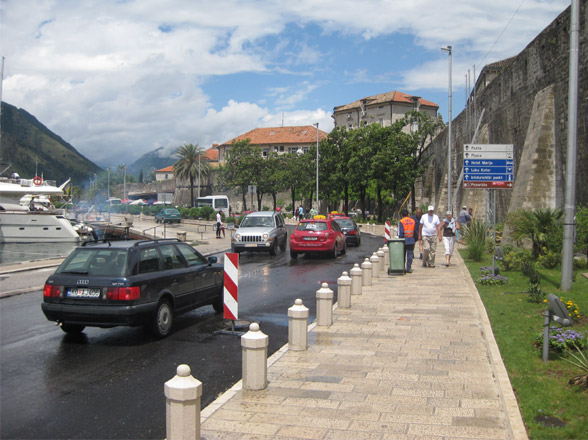
Downtown Kotor, Montenegro.
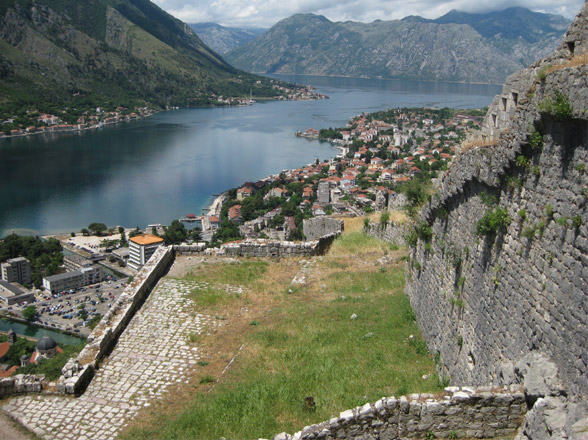
A view of the Bay Of Kotor from high above in the Kotor Fortress.

People walking the street in Sutmore, Montenegro.

Beach umbrellas lining the shore in Sutomore.

Nearly all of the food I purchased in Montenegro came from streetside vendors.

A crowded public beach on the Adriatic coast on Montenegro.

German men jumping off a boat into the Gulf of Kotor.

San Stefan, Montenegro

The coast of Montenegro, heading south toward Albania.
A typical day would involve sleeping in late, working for a couple hours, going on a bike ride or walk around town, and then returning in the evening for a shower, a warm meal, and a long night of computer work and writing.
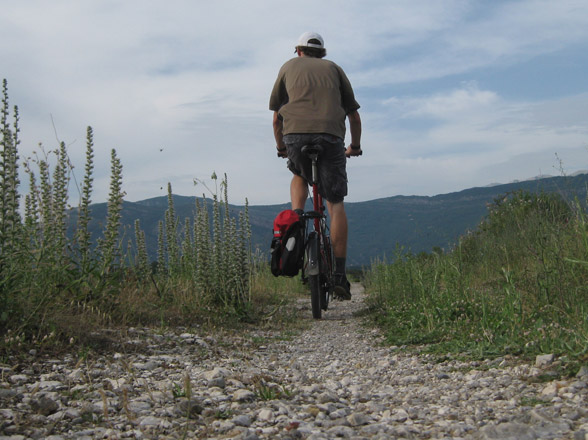
Here I am out on a day ride with my bicycle. I’m cycling across some lowland marshes.
Unfortunately, the Internet in Montenegro (or at least in the apartment I was renting) was incredibly unreliable. It seemed as though there was hardly a day where the Internet did not go out at least once. And on some occasions, the Internet would go out three to four times per day.
For someone who does not use the Internet all that often, this may not some like a big deal. But when your livelihood is made via the World Wide Web, like mine is, Internet outages are an incredible nuisance and an substantial drain of both time and money.
Every time the Internet would go out, I had to call Rakto, the apartment owner, or his son, Nino (who spoke better English than his father), to come over and reset the router and/or call the Internet company. I had thought the Internet in Croatia had been bad, but Montenegro was a million times worse.
During the 40 days I spent in Tivat, I would guess that at least half of my days were spent trying to get the Internet back up and running. It was frustrating, depressing, and a waste of time. I had planned to get a lot of work done while staying in Montenegro, but that didn’t really happen. Instead, most of my time was spent walking around town, simply waiting for the Internet to magically turn back on. And even after it did come back on, it would often times go out again just a few hours later.
It was terrible… and it made me realize just how much I love my home in the United States and how much my lifestyle depends on having a good, fast, reliable Internet connection.
Overall, the biking in Montenegro was good, the weather was hot, it rained a lot, the women were beautiful, the clothing was skimpy, men walked around with their shirts lifted high above their bellies, women watered their gardens in bikinis, dead animals were everywhere, I saw more naked people than I have ever seen before in my entire life, and the landscape of the country left me with nothing but positive impressions.
But after 43 days in Montenegro it was time to say goodbye and continue my journey south.
On the 24th of June I left my apartment in Tivat. There was no one to say goodbye to. No one to wave me off. I simply packed up my things, rolled my bike out to the street and took off toward Albania.
My temporary home along the Adriatic sea has quickly become a distant memory. But I am glad that I had the chance to experience the people and place they call Montenegro… and I will forever remember it as one of the most beautiful, friendly, and frustrating places I have ever been.

A sunset from the city park in Tivat, Montenegro.
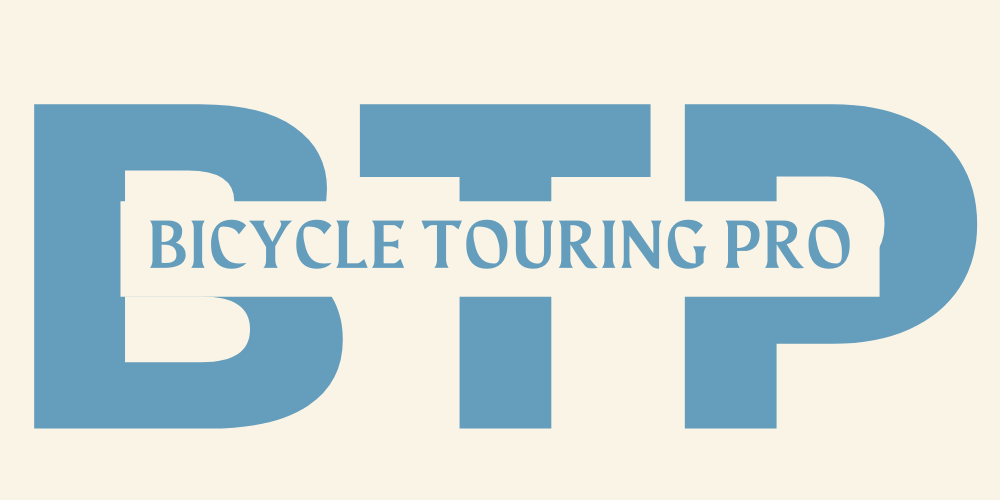

In many Eastern European countries you will find little care for animals – they simply have other priorities in life. I try not to judge because the views in the highly developed countries are very different and we have been tought that it is wrong to mistreat animals. I can definitely say I saw a similar thing when I travelled further to Cambodia and Vietnam.
What I do find amazing is the lack of need to entertain their brains – they can happily sit there doing nothing all day just looking at the floor. I don’t know if this is a bad reflection on us or them – because we have to always keep busy where as they are quite happy with a slow pace of life.
Keep us up to date with your travels 🙂
Great piece and nice pics too. The area looks really nice. Was it cheap for day to day things?
Staying in a place for a while is a good thing. Like you said you get much more of a “local” feel for a place. I have done it a few times and seen loads of things I would have missed if I’d only been there a few days.
Safe travels 🙂
Andreas, I think there is something to say for the fact that people here are much more content just sitting and doing nothing. I, and others like me, have a hard time doing this. Like you said, we feel as though we need to constantly be doing something. I would like to be able to just sit and relax in the way many people do, but it is very dofficult for me. So maybe I should learn something from the people here.
Andy. Yes, many of the day to day things were inexpensive. For example, bus trips to nearby cities cost about $2 – $3 USD, which I found to be a pretty good deal. Food was decently prized as well, but not outrageously cheap. And the Kotor Fortress, which was probably my favorite place in all of Montenegro, cost only 2 Euros, which in my opinion, was an excellent bargain. Best 2 Euros I have ever spent!
Do you know what happened to the puppies in the park? Taking the local culture into account, would someone have adopted them, or are there animal shelters? I realise this is just something you witnessed as a visitor, just makes me sad too.
I don’t know what happened to the puppies. I went back a short time later and they were gone. I imagine someone came by and picked them up, but what happened to them after that – I’m not sure.
Hi Isla,
I can’t really say whether it will be safe for you there. I felt pretty safe in Montenegro, but safety depends on a number of factors: sex, appearance, personal confidence, the way you carry yourself, luck, timing, common sense, the situations you put yourself in, etc. Generally, I feel that Montenegro is a pretty safe place, although it does have some rough edges at times and I would enter with a certain amount of caution, just as I would with almost any place in the world.
As far as routes go, this is the general route I took when cycling across the country and I would highly recommend it. https://goo.gl/maps/rW19W The only place I would say you MUST visit is the city of Kotor. Be sure to spend some time hiking to the top of the walled ruins there. They are even better than Dubrovnik in my opinion. And if you get up there on a clear day you will have some incredible views!
How can somebody from africa get to montenegro?
@ Isla : You will definitely be safe, 100% there aren’t rapist and random murderer lurking around the corner there. Its a tourist hot spot and Croatia is about to get into the E.U and so will Montenegro one day and Slovenia is already in it.
I have been to that region hundreds of times every chance i get i travel to former Yugoslavia, i have never had a bad experience. Next time try going to a internet cafe they are almost on every corner from my experiences. People there definitely live a slower graceful life and very stress free. While we worry about traffic and paying our mortgages and working all day long to come home to our tv , people over there worry more about family and having coffee and chocolates stocked fro when the neighbor comes by. People are very friendly there i been couch surfing and have met a lot of very nice fun people that way. As for the dog thing they do not value a dog as much we do here in the united States, they look at a dog as well a dog you could say. They don’t sleep and eat with them as we do here the dogs are 99% kept outside at all times and they don’t have a very good animal control and dog shelters like we do here. There are a ton of stray dogs but i have never encountered one that is out of line and has tried to bite anyone.
Next time your there try going to the north as well there are a ton of beautiful mountainous terrains and medieval castles as well. The best biking that i have experienced there has by far been the destination in Istria. The kilometres upon kilometres of gently rolling hills and rural roads make cycling a delight.
There are about 60 marked mountain bike trails, almost 2600 km worth, but not all of them are plotted on the Istria tourist board maps. So far, you can follow maps of 1500km of marked circular trails, about 70% of which pass through unpaved country roads or forest paths.
Northern Istria has nine circular trails about 400km long. The mountainous terrain make these the most difficult trails but the views are spectacular. Look for ones that pass through the hilltop village of Motovun or the tiny town of Hum. Central Istria has seven marked bike trails circling Pazin. These are relatively untouristed even in high season. Southern Istria has the easiest trails. The 300km of marked trails are divided into eight sections with a lot of riding along the coast. There are two bike trails around Porec but the most beautiful trails are around Zlatni rt park outside of Rovinj. There are also three marked trails around Vrsar that pass through the Kontija forest with a sweeping view of the Lim Channel.
Thanks for the amazing story and experience and im sure you will be more prepared next time best of luck.
Hi Tour pro,
I am Black American tourist presently in Serbia, how can I visit Montenegro from Serbia?
Secondly, do you get to see people of black decent in your everyday walk in Montenegro?
Expecting your respose.
Timmy Lawson
My husband and I had the privilege of touring in Kotor we soon discovered the area was rich in history and lived a very different lifestyle to what we are accustomed. The locals we felt were chilly and did not want to engage in conversation, which might help their tourism industry. However we later learnt that with the unrest that both government and other countries surrounding Montengro had brought to the surrounding area had left an identifiable mark on these people. I suggest should you travel to this area do your research about history and strife wrought on this beautiful place, this will give you a better picture of why and what make the inhabitants tick and perhaps even what if anything we can contribute on route to the area. Beautiful area.
Timmy,
As an American of Montenegrin descent, I have visited the place to see my family.
You will run into mostly Russians, Czechs & some Brits, but yes, I have seen African Americans on the beach there. I actually would have expected to see more Africans (Libyans, Egyptians), considering this is a coastal country.
I recall one man in particular caught my attention- NOT because of his ethnicity, but because he spoke with an American accent! At the time, my head was spinning trying to remember phrases in the Serbian language, and his voice was a welcome relief. I nearly walked up to him just to have a conversation.
You’ll be fine & the people will love you!